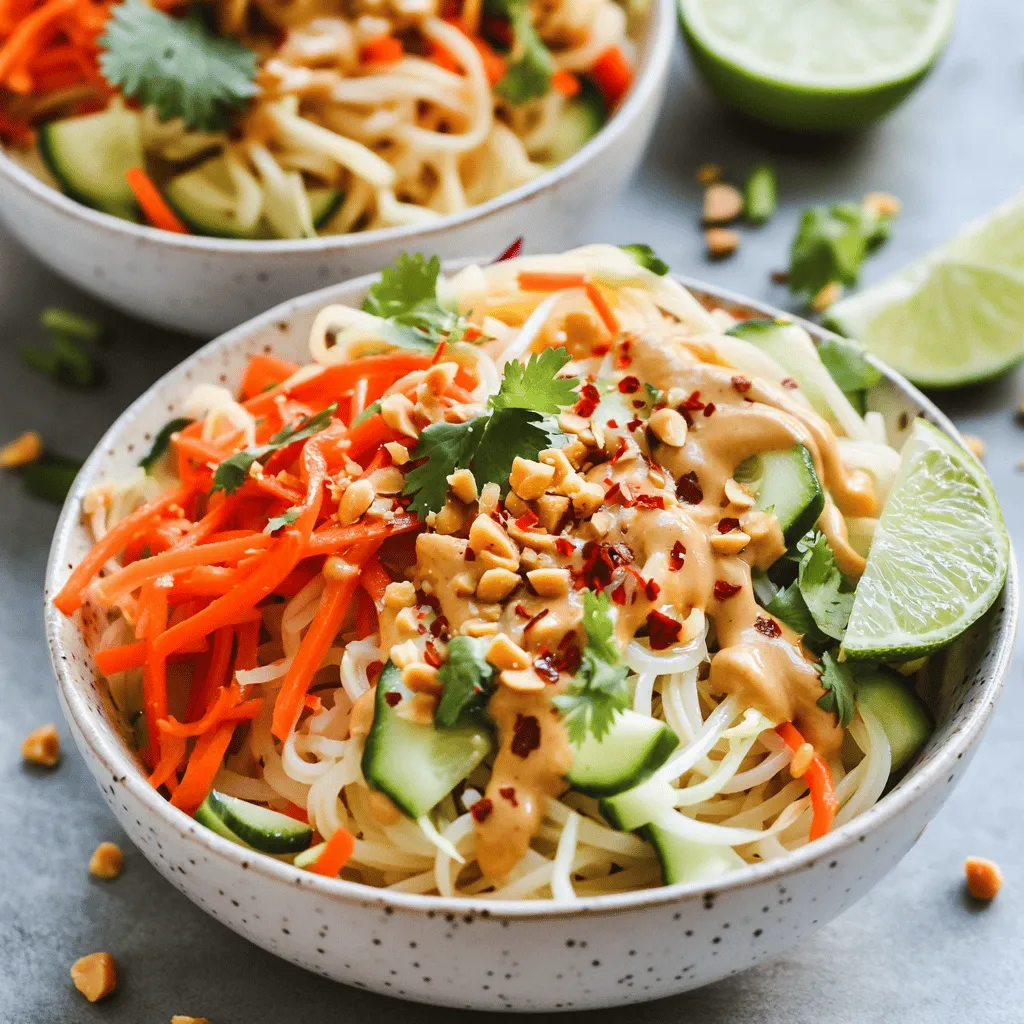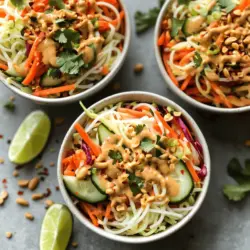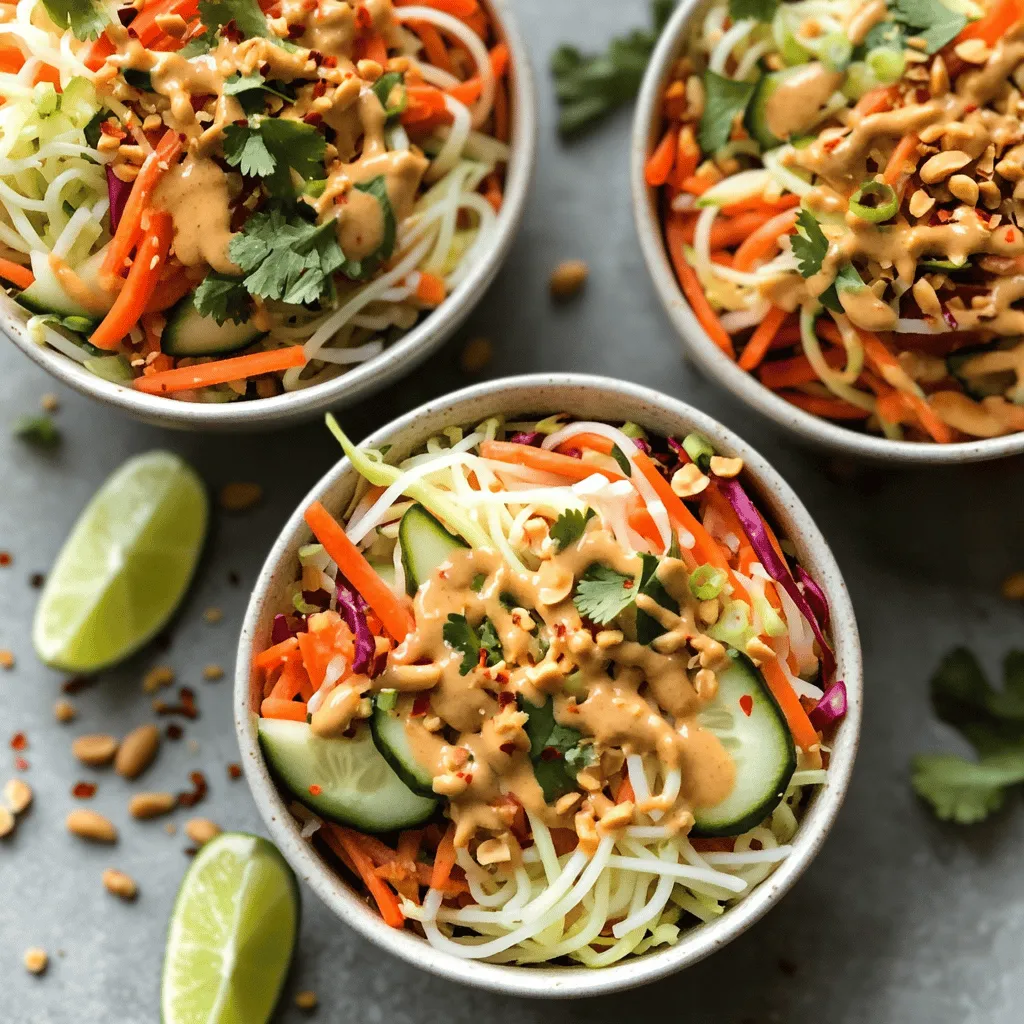Looking for a vibrant dish that’s bursting with flavor? Let me introduce you to Thai Peanut Noodle Salad! This salad combines soft rice noodles, fresh veggies, and a creamy peanut sauce that’ll make your taste buds dance. It’s easy to make and perfect for any meal. Whether you’re a busy parent or a culinary novice, this salad is your new go-to recipe. Ready to dive in? Let’s get started!
Ingredients
Main Ingredients for Thai Peanut Noodle Salad
- 8 oz rice noodles
- 1 cup shredded carrots
- 1 cup red bell pepper, thinly sliced
- 1 cup cucumber, julienned
- 1/2 cup red cabbage, shredded
- 1/4 cup fresh cilantro, chopped
- 1/4 cup green onions, sliced
- 1/2 cup roasted peanuts, roughly chopped
To make a vibrant Thai peanut noodle salad, you need fresh and colorful ingredients. The rice noodles serve as the base, offering a light texture. Shredded carrots add sweetness, while red bell pepper brings a crisp bite. Cucumber cools the dish, and red cabbage adds crunch. Fresh herbs, like cilantro and green onions, enhance the salad’s flavor and aroma. The roasted peanuts add a satisfying crunch and nutty richness.
Peanut Dressing Components
- 1/3 cup creamy peanut butter
- 2 tablespoons soy sauce
- 2 tablespoons lime juice
- 1 tablespoon honey or maple syrup
- 1 teaspoon sesame oil
- 1 clove garlic, minced
- 1 tablespoon ginger, grated
- Water to thin the dressing as needed
The peanut dressing is key to this salad. Start with creamy peanut butter for a rich base. Soy sauce adds saltiness, while lime juice gives a bright twist. Honey or maple syrup can sweeten the mix. Sesame oil brings depth, and garlic and ginger offer warmth. If the dressing is too thick, use water to achieve your desired consistency.
Step-by-Step Instructions
Cooking the Rice Noodles
How do I cook rice noodles properly? Start by boiling water in a pot. Add the rice noodles and cook them according to the package instructions, usually about 4 to 6 minutes. Stir them gently to keep them from sticking. Once done, drain the noodles.
What’s next? Rinsing and cooling the noodles is key. Place the drained noodles under cold running water. This stops the cooking. Rinse them well to remove excess starch. Once cooled, set them aside for later.
Preparing the Vegetables
How do I chop and slice vegetables? Use a sharp knife for clean cuts. For carrots, peel them and shred them with a grater. For red bell peppers, cut off the top and bottom, then slice them thinly. For cucumber, julienne it by slicing it into long, thin strips. Finally, shred the red cabbage into bite-sized pieces.
How do I combine the vegetative ingredients? In a large mixing bowl, add your carrots, sliced red bell pepper, julienned cucumber, shredded red cabbage, chopped cilantro, and sliced green onions. Toss them gently to mix.
Making the Peanut Dressing
What tips help achieve the perfect creamy texture? Start with creamy peanut butter in a bowl. Add soy sauce, lime juice, honey, sesame oil, minced garlic, and grated ginger. Whisk these together until smooth. If too thick, thin it with a little water until it’s pourable.
How can I adjust flavors for personal preference? Taste the dressing. If you like it sweeter, add more honey or maple syrup. If you want more zing, squeeze in extra lime juice or soy sauce.
Combining all Ingredients
What are the best practices for mixing noodles and vegetables? Add the cooled rice noodles to your bowl of veggies. Pour the peanut dressing over the top. Use tongs to gently toss everything together. Make sure every noodle and veggie is well coated.
How do I incorporate the dressing evenly? Continue to toss the salad until you see a beautiful mix of colors and textures. Finally, sprinkle chopped roasted peanuts over the top. Toss again gently to blend them in. Enjoy this rich and fresh dish!
Tips & Tricks
Perfecting Flavor and Texture
To make your Thai Peanut Noodle Salad shine, focus on balancing acidity and sweetness. Lime juice gives a bright taste, while honey or maple syrup adds sweetness. Start with one tablespoon of lime juice and one of honey. Taste as you mix. Adjust until you find harmony.
Next, consider the dressing’s consistency. A thick dressing can clump on the noodles. If it feels too thick, slowly add water, one teaspoon at a time. Whisk until it flows smoothly. This way, your salad stays light and fresh.
Serving Suggestions
To make your salad pop, use colorful garnishes. Fresh cilantro adds a burst of green. Lime wedges offer a zesty touch. A sprinkle of crushed red pepper flakes adds heat. These small details make your dish appealing.
For pairings, consider serving it with grilled chicken or shrimp. These proteins add heartiness. You can also enjoy it with spring rolls for a complete meal.
Common Mistakes to Avoid
One big mistake is overcooking the rice noodles. They should be tender but still firm. Cook them according to package instructions. Always rinse them under cold water to stop the cooking.
Another error is not balancing seasonings. If your salad tastes bland, add a bit more soy sauce or lime juice. Taste as you go to ensure a well-rounded flavor.

Variations
Dietary Adjustments
If you need a gluten-free option, you can use rice noodles. They are great and keep the dish tasty. For the dressing, switch out soy sauce for tamari. This makes it safe for those with gluten issues. You can still enjoy all the rich flavors.
For a vegan dressing, skip honey and use maple syrup instead. This small swap keeps the salad sweet and allows everyone to enjoy it. You won’t lose any flavor by making these changes.
Additional Ingredients to Enhance the Salad
Want to add more flavor? You can include protein, like chicken or tofu. Cooked chicken adds a hearty touch, while tofu keeps it light. Both options work well with the peanut dressing.
You can also think about other vegetables. Try adding snap peas for crunch or avocado for creaminess. You can even add radishes for a peppery bite. Each adds fresh flavor to the salad.
International Twists on the Recipe
Feel free to get creative with different Asian flavors. You can add sesame seeds or edamame for a fun twist. These ingredients give a unique taste while keeping it true to the dish.
Try incorporating regional ingredients too. For example, use Thai basil instead of cilantro. It will bring a fresh, fragrant taste. Even a splash of coconut milk in the dressing can give it a tropical flair. Each variation makes the salad new and exciting.
Storage Info
Best Practices for Storing Leftovers
To keep your Thai Peanut Noodle Salad fresh, store it correctly. First, let the salad cool to room temperature. You want to avoid steaming the salad in the container. Next, place the salad in an airtight container. This helps keep moisture out and flavors in.
If you make the salad in advance, it’s smart to keep the dressing separate. Dress the salad only when you’re ready to eat. This way, the noodles and veggies stay crisp. If you have leftovers, you can also pack them in smaller containers for quick meals.
Shelf Life
You can keep Thai Peanut Noodle Salad in the fridge for about three days. After that, it may lose its taste and texture. Always check for signs of spoilage. If you see any mold or off smells, do not eat it.
A good rule of thumb is to trust your senses. If it looks or smells funny, toss it out. This ensures you enjoy your salad at its best!
FAQs
How do I make Thai Peanut Noodle Salad ahead of time?
You can make this salad a few hours before serving. Cook the rice noodles and prepare the vegetables. Keep the dressing separate in the fridge. When you are ready to serve, combine everything in a bowl. This keeps it fresh and crunchy.
Can I use other types of noodles?
Yes, you can use other noodles. Try soba, udon, or even spaghetti. Just cook them according to package directions. Rinse them in cold water to stop cooking. This will keep your salad light and fresh.
What can I substitute for peanut butter?
If you need a peanut butter substitute, try almond butter or sunflower seed butter. Both options give a nice flavor. You can also use tahini for a different taste profile. Just keep in mind that the texture and flavor will change slightly.
Is Thai Peanut Noodle Salad healthy?
Yes, this salad is quite healthy! It has lots of fresh veggies and healthy fats from the peanuts. Rice noodles are low in fat and gluten-free. This dish is great for a light lunch or dinner.
Can I freeze leftover salad?
Freezing leftover salad is not ideal. The noodles and veggies can become mushy when thawed. It is better to store it in the fridge for a few days. Just make sure to keep the dressing separate to preserve freshness.
Where does the recipe for Thai Peanut Noodle Salad come from?
The recipe for Thai Peanut Noodle Salad comes from the rich culinary traditions of Thailand.Enjoy making this dish at home!
In this blog post, we explored the key ingredients for Thai Peanut Noodle Salad, from rice noodles to fresh veggies. We shared step-by-step instructions to cook the noodles and create a tasty peanut dressing. With tips on balancing flavor, serving ideas, and common mistakes, you can make this dish shine. Remember, variations allow for different diets and tastes, so feel free to experiment. Enjoy your homemade salad fresh or stored, and let your creativity enhance each bite!

